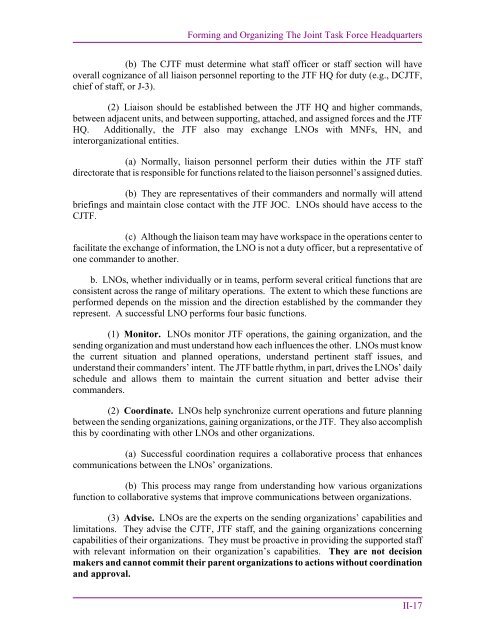JP 3-33, Joint Task Force Headquarters - Defense Innovation ...
JP 3-33, Joint Task Force Headquarters - Defense Innovation ...
JP 3-33, Joint Task Force Headquarters - Defense Innovation ...
You also want an ePaper? Increase the reach of your titles
YUMPU automatically turns print PDFs into web optimized ePapers that Google loves.
Forming and Organizing The <strong>Joint</strong> <strong>Task</strong> <strong>Force</strong> <strong>Headquarters</strong><br />
(b) The CJTF must determine what staff officer or staff section will have<br />
overall cognizance of all liaison personnel reporting to the JTF HQ for duty (e.g., DCJTF,<br />
chief of staff, or J-3).<br />
(2) Liaison should be established between the JTF HQ and higher commands,<br />
between adjacent units, and between supporting, attached, and assigned forces and the JTF<br />
HQ. Additionally, the JTF also may exchange LNOs with MNFs, HN, and<br />
interorganizational entities.<br />
(a) Normally, liaison personnel perform their duties within the JTF staff<br />
directorate that is responsible for functions related to the liaison personnel’s assigned duties.<br />
(b) They are representatives of their commanders and normally will attend<br />
briefings and maintain close contact with the JTF JOC. LNOs should have access to the<br />
CJTF.<br />
(c) Although the liaison team may have workspace in the operations center to<br />
facilitate the exchange of information, the LNO is not a duty officer, but a representative of<br />
one commander to another.<br />
b. LNOs, whether individually or in teams, perform several critical functions that are<br />
consistent across the range of military operations. The extent to which these functions are<br />
performed depends on the mission and the direction established by the commander they<br />
represent. A successful LNO performs four basic functions.<br />
(1) Monitor. LNOs monitor JTF operations, the gaining organization, and the<br />
sending organization and must understand how each influences the other. LNOs must know<br />
the current situation and planned operations, understand pertinent staff issues, and<br />
understand their commanders’ intent. The JTF battle rhythm, in part, drives the LNOs’ daily<br />
schedule and allows them to maintain the current situation and better advise their<br />
commanders.<br />
(2) Coordinate. LNOs help synchronize current operations and future planning<br />
between the sending organizations, gaining organizations, or the JTF. They also accomplish<br />
this by coordinating with other LNOs and other organizations.<br />
(a) Successful coordination requires a collaborative process that enhances<br />
communications between the LNOs’ organizations.<br />
(b) This process may range from understanding how various organizations<br />
function to collaborative systems that improve communications between organizations.<br />
(3) Advise. LNOs are the experts on the sending organizations’ capabilities and<br />
limitations. They advise the CJTF, JTF staff, and the gaining organizations concerning<br />
capabilities of their organizations. They must be proactive in providing the supported staff<br />
with relevant information on their organization’s capabilities. They are not decision<br />
makers and cannot commit their parent organizations to actions without coordination<br />
and approval.<br />
II-17

















